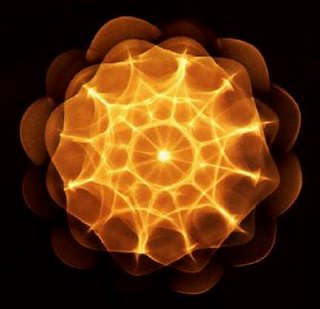 There is a video called Cool Salt making the rounds of the Internet science blogs (WARNING: turn the volume on your speakers or headphones down before you play the video. Some of the frequencies will hurt your ears if you don't).
There is a video called Cool Salt making the rounds of the Internet science blogs (WARNING: turn the volume on your speakers or headphones down before you play the video. Some of the frequencies will hurt your ears if you don't). What the video shows are the standing wave patterns produced by exciting an elastic sheet with salt on it using an audio tone generator. The tone generator is then tuned through audible frequencies, pausing at obvious resonant frequencies of the sheet (i.e. frequencies where it produces standing waves determined by the dimensions of the sheet). The salt settles into patterns that help you to visualize the standing waves set up at the resonant frequencies. I read one blog comment by a competent-seeming person that said that the salt settles to the points where the sheet is not displaced at all, but that doesn't sound quite right to me. Maybe I'm missing something, but it seems to me that the salt should settle to the lowest points of the standing wave, which would be a regular pattern of sationary dips. I'll have to give this some more thought (or, even better, just do the experiment in my next lecture on audio). If any of you readers have any additional insight, please post a comment!
This type of demonstration is a classic one used in high school and university physics classes around the world. The study of these patterns can be traced back to Ernst Chladni (a modern founder of the science of acoustics) and his student Hans Jenny, who popularized the study of such patterns in his 1967 book Cymatics (from the Greek word "kyma" meaning "waves"). "Cymatics" is now the recognized term for the study of wave phenomena.
(Hat tip: Digg)
(Image Source: a Chladni figure found in the Wiki entry on Cymatics)

2 comments:
Wow! I loved watching that (Evidently I missed out in High School) Thanks!
Can't really see it in the video, but it sounds right that the salt should settle to the points of no displacement...because the standing wave vibration would mean the actual lowest points on the sheet would also be the highest points so the salt settles in the bits that aren't moving? or is that just silly? It's been a while since I've learnt this stuff!
I guess that depends on whether the "standing wave" is actually standing still or not. I can imagine how your theory/expectation could be true as follows: If the nodes at zero displacement are stationary and
the areas of positive and negative displacement of the wave 'swap' positions over and over, then my expectation is that the salt would also try to move back and forth, constantly trying to slide down the slope. Then the frequency of the resonance becomes an issue - if the frequency is high enough the salt would never get very far before the positive and negative areas swapped and therefore it would appear that the salt 'settled' into the nodes of zero displacement, as you expected.
That could be the case, but I'm still not convinced that is what will happen. My next lecture is later this month and I will try and set up at least a miniature version of the experiment and give it a go.
Post a Comment